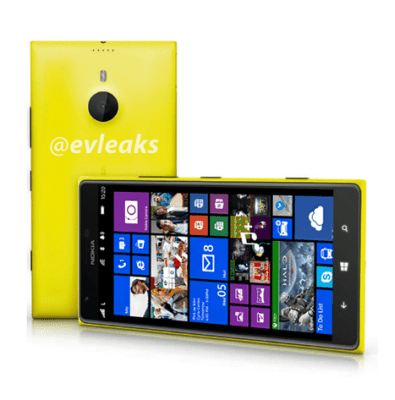Nokia has been rumoured to be preparing a Windows Phone-powered phablet for many months, to expand the upper echelons of its smartphone portfolio and battle Samsung’s Galaxy Note line (the latest of which, the Note 3, was unboxed only this week). Images purporting to depict a palm-stretching handset carrying Nokia’s branding have also cropped up online before now, but today prolific leaker @evleaks has posted a press image in Nokia’s typical style.
The image shows what’s evidently a larger than usual Windows Phone, with enough screen real estate to display 11 x 6 rows of icons (vs the 7 x 4 icons that the 4.5 inch Lumia 925 accommodates). The other notable feature is the gently protruding rear camera which looks to be the same as the 925’s PureView-branded 8.7MP lens — so not, in other words, the 41MP ‘true PureView’ Lumia 1020.
Nokia hasn’t officially confirmed its phablet launch plans, but the pattern of an increasing flow of leaks is consistent with other leaky Lumia launch trajectories (such as the Lumia 1020). It’s certainly no secret that Nokia has been weighing up getting into the phablet space on Windows Phone — and doing so for a long time. Back in February 2012 the company told TechCrunch that it was “looking closely [at the mid-size tablet market] and looking to see whether it will catch on”.
In the event, Samsung has continued building momentum in the category, while smartphone screens generally have inflated in size to try to keep up with the trend for bigger phones. Meanwhile Nokia has faced an uphill battle trying to sell its smartphones in a market dominated by Android and iOS. Indeed, it’s been such a struggle for the company that, at the start of this week, it confirmed it would be throwing in the towel by selling its Devices & Services unit to Microsoft for $7.2 billion and licensing its brand name for use by Redmond on mobiles and smartphones.
That transaction is not due to close til the first quarter of 2014, though, so Nokia has a few more months of pushing phones ahead of it. The Windows Phone phablet is named in @evleaks’ tweet as the Nokia Lumia 1520 and includes this year’s date — indicating a 2013 launch, which suggests Nokia will be launching the device, rather than letting Microsoft do the honours.
Getting into the phablet making-game — even at this late stage — is one way for Nokia to try to make its devices stand out against the iPhone, which has remained sub-phablet sized, despite Apple increasing the screen size of its current flagship iPhone 5 to 4 inches (up from 3.5 inches). But it’s not going to help Lumia stand out against Android, as many Android OEMs have been ploughing the big phone furrow for some time. As well as the Galaxy Note line (and Samsung’s other phablet brand, Mega), a Nokia phablet would compete with phablets from the likes of Sony, LG and Huawei.
Add to that, Apple continues to be rumoured to be testing bigger screen iPhones — albeit, testing different form factors is simply due diligence in such a competitive market as smartphones. It remains to be seen whether a phablet-sized iPhone will end up going into production — a Reuters report has previously suggested Apple is considering a 2014 timeframe for that. Meanwhile Cupertino of course has its iPad mini and full fat iPad to cover off the larger form factor tablet space in its portfolio (Nokia is rumoured to be lining up a Windows RT tablet too — doubtless on its soon-to-be-phone-owner Microsoft’s instructions).
Returning to the Lumia phablet, at the end of the day, a larger screen is not what Windows Phone needs to lure consumers away from Android and iOS. It needs more developers to make better apps — but with Android dominating market share and iOS still leading on app monetisation there’s precious little reason for developers to prioritise Microsoft’s OS.
And, from the consumer perspective, Windows Phone remains a solution looking for a problem. Android and iOS continue to be successful because of their apps focus and app-centric UIs. Just offering something different is not in itself enough of a reason for choice-spoilt consumers to care at this point — as the failure of Facebook’s Android launcher/app replacer, Home, also underlines.
